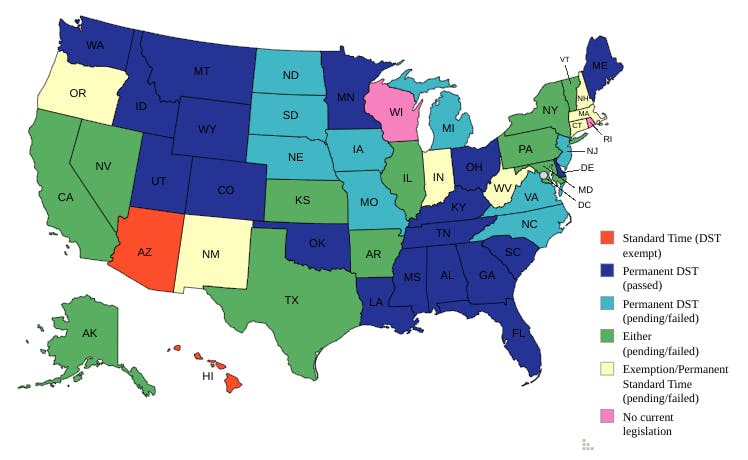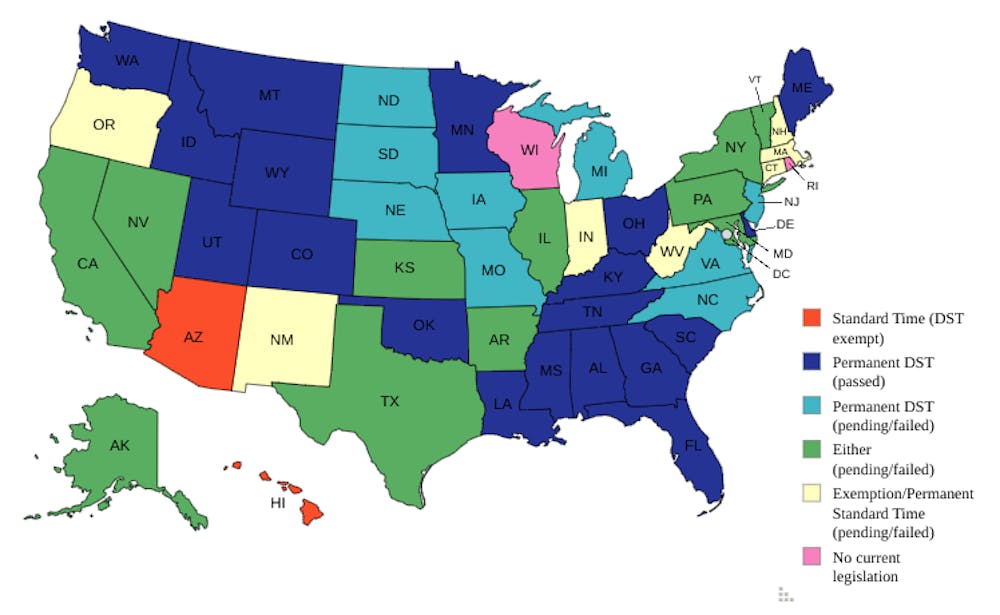Changing the clocks is a practice long overdue for revision. However, states attempting to “lock the clock” and stay on permanent daylight saving time (DST), including Ohio, have it all wrong: The healthiest and safest option is permanent standard time, lest we subject ourselves to dark mornings and the slew of effects associated with chronic circadian misalignment.
On Nov. 3, we set our clocks to "fall back" as we engaged in our biannual ritual of changing the time. For those unaware and unconcerned individuals who simply trusted their phone's programming, they may only have been struck by the surprise of the sun rising now at 7 a.m. rather than 8.
Our move from daylight saving time (DST) to standard time marks a stint of four months of time synchronicity between all 50 states before 48 of us heedlessly “spring forward” come March 9, 2025.
While time changes may seem inconsequential, they are a hindrance at best and a deadly hazard at worst. Until federal legislation puts a definitive end to the cycle of switching, it is up to states to choose whether they want to continue this odd practice.
Under the Uniform Time Act, which officially implemented DST in 1966, states are allowed to exempt themselves from DST and practice permanent standard time. Currently, Arizona and Hawaii are the only states not observing DST. American territories also do not observe DST.
However, relatively few states have introduced legislation for permanent standard time, and none of them have yet to pass this legislation. Otherwise, more than 30 states in the past five years that have either introduced legislation or even succeeded in passing legislation on permanent DST, but none of the laws can go into effect unless Congress were to repeal the Uniform Time Act. This may or may not happen in the near future.

The Sunshine Protection Act, which was introduced in 2018 by senators Marco Rubio and Edward Markey, would put the U.S. on permanent DST. This legislation has stalled in the House multiple times, much to the frustration of people who just want the clock to stop changing.
However, the effects of permanent DST versus permanent standard time need to be considered carefully.
Advocates of permanent DST cite economic benefits derived from the “extra” hour of light in the evening as well as safety benefits including reduced crime and reduced accidents.
However, empirical studies provide greater evidence for the health and safety benefits of standard time. Additionally, while some individuals may take issue with the switch from DST to standard time on account of the effects the shorter days have on mood and mental health, staying on DST may even be worse for conditions like seasonal affective disorder in the winter months since the sun would rise as late as 9 a.m.
To understand why there’s so much fuss about the clocks changing in the first place, it’s important to recognize the acute effects of the time changes, particularly “spring forward,” on public health as it relates to sleep deprivation, accident risk and a general increase in risk for health conditions.
A study in the Journal of Applied Psychology found that Americans lost an average of 40 minutes of sleep during the spring transition. This coincides with an increased risk for accidents, particularly on the road and in the workplace.
An analysis of traffic accidents from 1996-2017 found that there was a six percent increase around the spring transition, primarily due to driver sleepiness and morning darkness. The researchers suggested that 28 fatal accidents could be prevented each year if the time change were eliminated.
In terms of health risk, studies have documented that the disturbance to the body’s biological clock is tied to increased risk of various health conditions. One study found that heart attacks increase 24% on the Monday following the spring transition, and while other studies may not agree to the exact degree, a meta-analysis in the Journal of Clinical Medicine indicated a “modest but significant” increase in heart attack risk following the spring transition.
Additionally, relative risk for other health conditions, such as immune conditions and digestive disorders, was shown to increase 10% after the DST transition. The researchers estimated that 150,000 incidences of negative health effects in the U.S. were associated with this transition.
However, all the risks seen in the spring transition are notably absent in the fall transition, though the downsides and dangers of DST don’t stop after our spring forward.
From past attempts to implement permanent DST in other countries and within our own, there have been numerous ill effects, primarily in the form of darkness and its safety implications.
From 1968-1971, the U.K. tried out permanent DST (or what they called British Standard Time), but the policy fell flat. In more northern regions, like Scotland, it was particularly unpopular due to safety issues posed by morning darkness.
The U.S. tried its own permanent DST experiment in 1974 amidst an energy crisis. The experiment was supposed to last two years, but it ended the same year it started, especially after the deaths of eight schoolchildren in Florida. According to the National Opinion Research Center at the University of Chicago, 79% of Americans had favored DST at the start of the experiment, but this rating fell to 42% in only a few months.
Most recently, Russia tried permanent DST from 2011-2014, but despite initial enthusiasm, Russians living in northern regions were said to have experienced stress and health problems as a result of the morning darkness.
As it stands, the U.S. and Europe are primarily the only regions of the world practicing DST.
However, so long as we stay on DST, we are allowing for a chronic misalignment of our social and biological clocks that can result in “social jet lag” and increase health risks.
Our circadian rhythms, or biological clock, are most influenced by cycles of light and darkness set by the sun. Research on biochemical responses associated with sleep-wake patterns found that they remained determined by the sunrise, suggesting that the sleep-wake cycle does not adapt to arbitrary times like DST. Social jet lag denotes a misalignment between the social clock set by policymakers and the biological clock set by the sun.
Chronic social jet lag was observed in children and adolescents during Russia’s trial with permanent DST, and the researchers noted effects on sleep habits, mood and behavior. They also noted that the number of people experiencing social jet lag significantly decreased after Russia changed to permanent standard time.
Associated effects of social jet lag include higher incidences of depression and anxiety disorders, increased risk of metabolic disorders, higher rates of cardiovascular problems, and problems with cognitive and academic performance.
Perhaps not surprisingly, many professional organizations have endorsed permanent standard time, primarily for health and safety reasons. Organizations include the American Academy of Sleep Medicine, the American College of Occupational & Environmental Medicine, the National PTA, the National Safety Council and the National Sleep Foundation.
By comparison, permanent DST has been endorsed by the Chamber of Commerce and some golf and travel lobbyists.
That being said, if continuing our nonsensical time changes or choosing permanent DST were our only options, I would take permanent DST. At the moment however, standard time not only is a path of less (legislative) resistance, it's also the healthier option.
Whether our country ends up on DST or standard time may not matter to some individuals, but in the end, we should ask ourselves whether the long summer evenings are worth the personal and public health risks presented by months of dark mornings and chronic social jet lag.








